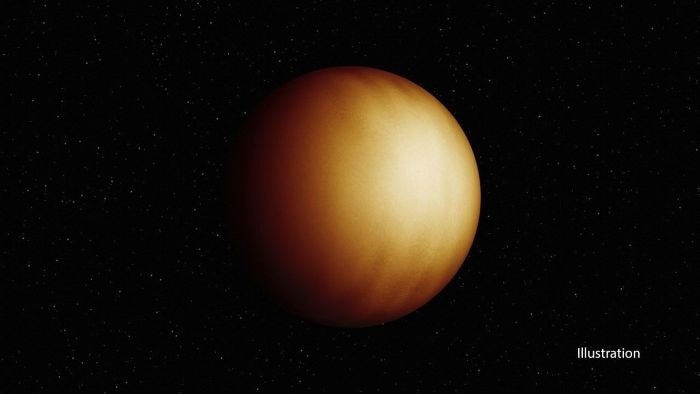Astronomers have created the first three-dimensional (3D) map of a planet orbiting another star, revealing an atmosphere with distinct temperature zones – one so scorching that it breaks down water vapor, a new study reveals.
 WASP-18 b, seen in an artist concept, is a gas giant exoplanet 10 times more massive than Jupiter that orbits its star in just 23 hours. Image Credit: NASA/JPL-Caltech (K. Miller/IPAC)
WASP-18 b, seen in an artist concept, is a gas giant exoplanet 10 times more massive than Jupiter that orbits its star in just 23 hours. Image Credit: NASA/JPL-Caltech (K. Miller/IPAC)
The temperature map of WASP-18b – a gas giant known as an 'ultra-hot Jupiter' located 400 light years from Earth – is the first to apply a technique called 3D eclipse mapping, or spectroscopic eclipse mapping.
An international team of researchers, including Dr Anjali Piette from the University of Birmingham, have developed a 3D model that builds on a 2D model published by the same team in 2023. That model demonstrated eclipse mapping’s potential to leverage highly sensitive observations by NASA’s James Webb Space Telescope (JWST).
Publishing their findings today (28 Oct) in Nature Astronomy, researchers say that, for many similar types of exoplanets observable by JWST, they can now begin mapping atmospheric variations – just as Earth-based telescopes long ago observed, for example, Jupiter’s Great Red Spot and banded cloud structure.
Co-author Dr Anjali Piette commented: "It's really exciting to be able to see an exoplanet in 3D. Most exoplanets are so close to their bright host stars that we can't take images of them like the solar system planets - but spectroscopic mapping gives us a new window into their 3D structures."
Detecting exoplanets at all is difficult – they typically emit much less than one percent of a host star’s brightness. Eclipse mapping requires measuring small fractions of that total as a planet circles behind its star, obscuring and revealing parts of it along the way.
Scientists can link minute changes in light to specific regions to produce a brightness map that, when done in multiple colors, can be converted to temperatures in three dimensions: latitude, longitude and altitude.
Lead author Ryan Challener, a postdoctoral associate at Cornell University, commented: “You’re looking for changes in tiny portions of the planet as they disappear and reappear into view, so it’s extraordinarily challenging.”
WASP-18b, which has roughly the mass of 10 Jupiters, orbits its host star in just 23 hours and has temperatures approaching 5,000 degrees Fahrenheit – provided a relatively strong signal, making it a good test case for the new mapping technique.
While the earlier 2D map utilized a single light wavelength, or color, the 3D map re-analysed the same observations from JWST’s Near-Infrared Imager and Slitless Spectrograph (NIRISS) instrument in many wavelengths. Each color corresponded to different temperatures and altitudes within WASP-18b’s gaseous atmosphere that could be pieced together to create the 3D map.
This new view confirmed spectroscopically distinct regions – differing in temperature and possibly in chemical composition – in WASP-18b’s visible ‘dayside’, the side always facing the star due to its tidally locked orbit.
The planet features a circular ‘hotspot’ where the most direct starlight lands, and where winds apparently are not strong enough to redistribute the heat. Surrounding the hotspot is a colder ‘ring’ nearer the planet’s outer visible edges, or limbs. Measurements showed lower levels of water vapor in the hotspot than WASP-18b’s average.
“We think that’s evidence that the planet is so hot in this region that it’s starting to break down the water,” Challener said. “That had been predicted by theory, but it’s really exciting to actually see this with real observations.”
He added that additional JWST observations could help improve the first 3D eclipse map’s spatial resolution. Already the technique can help illuminate the temperature maps of other hot Jupiters, which make up hundreds of the more than 6,000 exoplanets confirmed to date.
“This new technique is going to be applicable to many, many other planets that we can observe with the James Webb Space Telescope,” Challener said. “We can start to understand exoplanets in 3D as a population, which is very exciting.”
The research was supported by JWST’s Transiting Exoplanet Community Early Release Science Program.